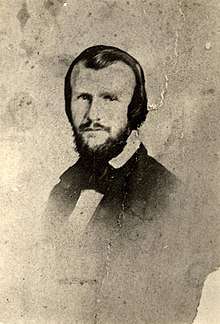Horace Lawson Hunley
Horace Lawson Hunley (December 29, 1823 – October 15, 1863) was a Confederate marine engineer during the American Civil War. He developed early hand-powered submarines, the most famous of which was posthumously named for him, CSS H. L. Hunley.
Horace Lawson Hunley | |
|---|---|
 | |
| Born | December 29, 1823 Sumner County, Tennessee |
| Died | October 15, 1863 (aged 39) Charleston, South Carolina |
| Buried | |
| Allegiance | |
| Battles/wars | American Civil War |
Biography
Horace Lawson Hunley was born in Sumner County, Tennessee to Louisa Harden Lawson and John Hunley. After relocating to New Orleans, Hunley studied law at the University of Louisiana and was admitted to the bar in 1849. He served in the Louisiana State Legislature and practiced law in New Orleans.[1]
In response to the Union blockade of southern ports the Confederate government offered bounties of up to $50,000 to anyone who sank a Union warship. In the summer of 1861, the Reverend Franklin Smith advocated southern businessmen pursue submarine warfare, in writings to Southern newspapers.[2] At this time Hunley joined engineer James R. McClintock and Baxter Watson in building the Pioneer (submarine). In order to prevent her capture, the submarine had to be scuttled during trials in Lake Pontchartrain when New Orleans fell to Union forces in early 1862.[3]
Hunley, with McClintock and Watson, followed by building the American Diver. The second submarine was towed to Fort Morgan and attempted an attack on the Union blockade of Mobile. However, the submarine foundered in foul weather and sank in the mouth of Mobile Bay.[4]
Hunley organized and funded a third submarine, the H. L. Hunley, by himself. After a demonstration held on July 31, 1863 was successful by sinking an old barge the submarine was transported to Charleston harbor and presented to General P.G.T. Beauregard. Five men from the first crew of H. L. Hunley died during early tests when she was accidentally swamped by the wake of a passing ship through her open hatches; four managed to escape. A second crew was recruited in Charleston. On October 15, 1863, though he was not part of the crew, Hunley decided to take command during a routine exercise. The vessel again sank, and this time all eight crew members were killed, including Hunley himself. The vessel was later raised and used again in 1864 in the first successful sinking of an enemy vessel (USS Housatonic) by a submarine in naval history. The operation was also fateful for H. L. Hunley, which sank a third time, and for the second time losing all hands.[5]
Horace L. Hunley was buried with full military honors at Magnolia Cemetery in Charleston, South Carolina, on November 8, 1863.
References
- Duncan (2015), pp. 188–189.
- Hicks (2014)
- Pizzuto (2001)
- Sledge (1966), pp. 377–378.
- Pizzuto (2001)
Bibliography
- Duncan, Ruth H. (1966). "The Captain and Submarine CSS H. L. Hunley". Tennessee Historical Quarterly. 25 (4): 377–378. JSTOR 42622906.
- Hicks, Brian (January 2014). "One-Way Mission of the H. L. Hunley". Naval History Magazine. Vol. 28 no. 1. U.S. Naval Institute.
- Pizzuto, Greg (2001). "The Life and Death of H.L. Hunley". The Charger. The Cleveland Civil War Roundtable (Fall). Archived from the original on 9 April 2019.
- Sledge, John S. (29 May 2015). The Mobile River. University of South Carolina Press. pp. 188–189. ISBN 978-1-61117-486-1.